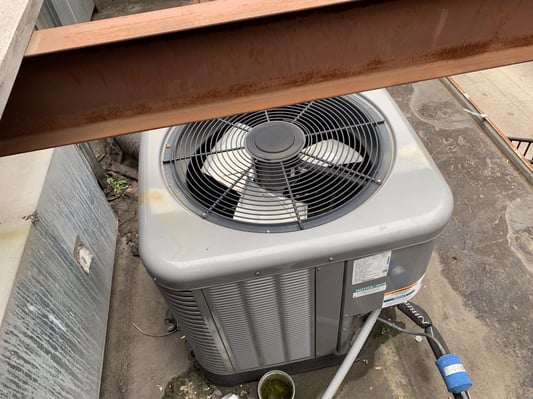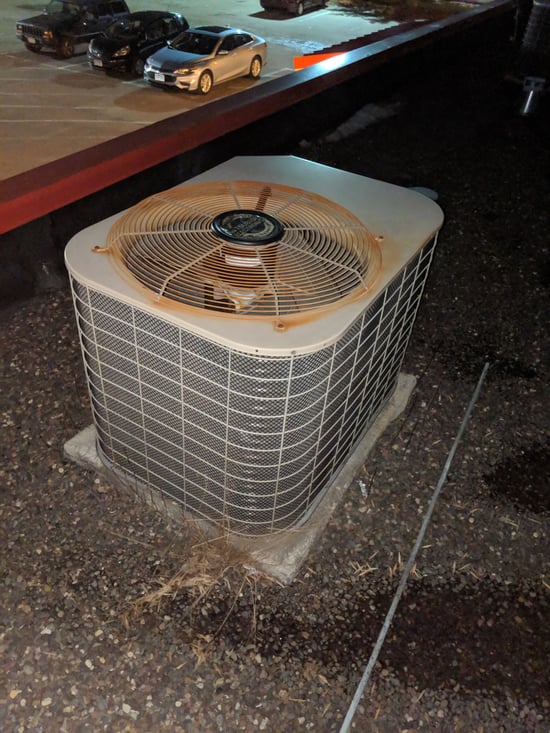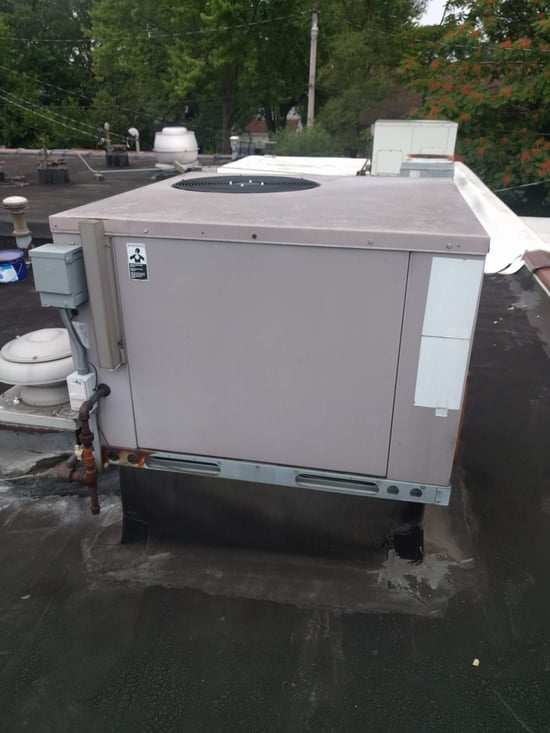It’s a sweltering Southern summer day, and customers are coming to your restaurants in droves for cold drinks and a chance to escape the heat.
But there’s a big problem: the sweat on the brows of your customers doesn’t seem to dry. The kitchen is even stuffier than usual. And it’s looking like ice is starting to melt as soon as it drops from the machine.
A comfortable environment is critical for restaurants. So if your customers and staff aren’t at ease with the ambient temperature, you could lose valuable business—and maybe even employees.
Commercial air conditioning (AC) systems maintain low temperatures throughout interior spaces to keep people cool. So what do you do when your AC won’t work when you need it the most? Don’t sweat it—consider this an entry-level guide to understanding this vital part of restaurant infrastructure.
Table of Contents
What is commercial AC?
Commercial AC is the “AC” within the HVAC acronym. Where the Heating system increases indoor temperature and the Ventilation system removes polluted air and replaces it with fresh air, Air Conditioning systems decrease indoor temperatures.
Looking for general information about HVAC? Check out The 86 Repairs Guide to Commercial HVAC!
The two common commercial AC systems within restaurants are:
Split, a type of HVAC system that has both exterior and interior components. In split HVAC systems, the compressor and condenser are outside the building, usually on the roof. Cooled air is then carried through ducts into different interior areas and dispersed through vents.
Multi-split, an HVAC system that doesn’t require ductwork. In multi-split systems, up to five different air outlets can be linked to the compressor through refrigerant lines. Cool air is then available in the areas where air outlets are present.
Unfortunately, keeping restaurant temperatures low can come at a high R&M price.

Numbers to know about commercial AC repair
At 86 Repairs, we collect and document data about HVAC repairs and not individual needs within Heating, Ventilation, and Air Conditioning since one issue within that infrastructure can affect its entire ecosystem.
If you’re hungry for more restaurant equipment and infrastructure data, download The State of Repairs. It’s the only report where this information is publicly available.
In 2021, 12.4% of repairs for our customers were related to HVAC issues. Because working HVAC is necessary for restaurants to open their doors, it may send a chill down your spine to learn that it’s one of the most expensive pieces of infrastructure to fix:
- The average invoice cost for HVAC repair in 2022 was $976.65.
- The first-time fix rate for HVAC is 90%. One out of every ten HVAC repairs required a second visit before they were resolved.
No need to lose your cool over the numbers. With preventative maintenance and troubleshooting, you and your team can continue going with the (air) flow and potentially avoid extensive downtime.
Maintenance to avoid commercial AC repair
Considering the expense associated with HVAC repairs, it’s in the best interest of your business to avoid emergencies as much as possible. We recommend scheduling preventative maintenance from a professional HVAC technician who can clear furnaces, check burners and carbon monoxide levels, and look for leaks throughout the system.
Between those vendor visits, a maintenance schedule will help you and your team to get proactive in R&M management. Here’s what we suggest:
Clean or replace air filters
When filters are clogged in an HVAC system, air can’t flow properly—defeating the purpose of the infrastructure. Depending on the type of HVAC system installed at your restaurant, filters can be found around different intake points, like the kitchen, dining room, or even the back office. Don’t forget about your makeup air unit on the roof, too.
- The makeup air unit is a large metal box located on your building’s roof. You’ll know it’s the right piece of infrastructure if you see a piece of metal coming from it at a 45-degree angle into the air.
- The makeup air unit has metal mesh air filters. Find these under the angled metal piece.
- Take the filters out of the makeup air unit. Clean them with soap or another metal-safe solution then rinse them off with a hose.
- When the filters are clean, dry them off and put them back in the unit.
- Inside, look for paper mesh panels behind access panels. These should be replaced every quarter, at minimum. If the environment is especially dirty, replace them more frequently.
Reprogram thermostats
When seasons change, your thermostats should, too. Most restaurants don’t think to automatically program the thermostat to change from heating to cooling (or the other way around).
So, if your indoor temperature seems too hot when the AC is running, double-check the thermostat is on the correct setting.
Examine the rooftop package unit
If your AC doesn’t seem like it’s cooling your spaces and the thermostat is correctly programmed, you could have an issue with the HVAC’s rooftop package unit. You’ll want to check the unit’s condenser coils—they might have buildup from airborne contaminants, like dirt or plant material.
- Use condenser coil cleaning spray to remove debris from dirty coils.
- Rinse off the spray and debris with a hose, then dry off the coils and put them back in the package unit.
Cold weather can also be a factor in underperforming condenser coils. So if they’re frozen, turn your HVAC system off overnight and allow them to defrost.

Troubleshooting to avoid commercial AC repair
Don’t lose your cool when your AC seems to be down. Try these troubleshooting tips before you contact an HVAC professional.
AC system not cooling
Room not getting to temp? Make sure you didn’t set the thermostat at an extremely low temperature. No matter how low you set that number, your system will always cool at the same rate. So, when you’re trying to get a space to cool down, change the thermostat to a reasonable temperature first to avoid freezing or overheating coils.
Once you’ve confirmed the thermostat is at a reasonable number,
- Check the thermostat to ensure it’s set to the cool setting vs. heat. Consider programming your thermostat to change this automatically during seasonal shifts vs. relying on your staff’s memory.
- You might need to reset your HVAC system if the thermostat is correctly programmed and the system still isn’t cooling.
- Force reset the system by toggling breakers off for at least 30 seconds, then turn them on again.
If you can’t even check the thermostat settings because it’s blank,
- Verify the batteries are still working. Try changing them with a fresh pair to see if it gives the display power.
- New batteries, no life? It could be because the makeup air unit doesn’t have power.
- Toggle the breakers for at least 30 seconds, then turn them back on.
When these troubleshooting steps don’t get your spaces to start cooling, you’ll need to call a technician.
Leak present
For folks who aren’t trained in specialized repair services, it’s incredibly difficult to determine the exact source of a leak. So before you call a vendor in to take a look, know which vendor you actually need to call!
- If you have a leak during wet weather, it’s probably due to a roof issue. See if the leak persists when the outdoor weather dries up.
- If you have a leak during optimal weather conditions, your leak is likely from the HVAC system. Call your technician to investigate further.
Warranties for commercial AC repair
If you’re certain your AC system—and the HVAC system at large—needs to be seen by a specialist, check your warranty status before making any call for dispatch. This is best practice for every piece of equipment and infrastructure in your kitchens; after all, why would you want to pay out of pocket for a repair if the unit is still guaranteed to perform?
Was your restaurant building built within the last year? If so, check for warranty status with your general contractor first. It’s common for them to cover repairs within the first year the building was constructed. For further guidance on warranty coverage, go directly to the manufacturer of your HVAC system.
The various components of an HVAC system could be covered by different warranties, so make sure you and your team are crystal clear on what’s covered and for how long before requesting service.

A final note on commercial AC repair
Repairs and maintenance can finally feel like a breeze. With a preventative maintenance schedule, routine maintenance, and smart troubleshooting, a broken AC system doesn’t have to ice your business out of profits.
Looking for something even more refreshing? We can take repairs off your plate completely. Learn how restaurants across North America partner with 86 Repairs for 24/7/365 support to control facilities, minimize downtime, and reduce R&M expenses—book a demo today!